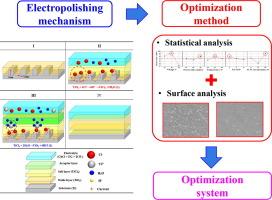在环保型电解液中利用田口稳健设计和表面分析优化钛的电抛光工艺
IF 6.9
2区 材料科学
Q2 CHEMISTRY, PHYSICAL
引用次数: 0
摘要
在本研究中,采用田口稳健设计和表面分析对钛在环保电解质中的电抛光工艺进行了优化。参数包括电压、工艺时间、电解液比、加入蒸馏水浓度和温度。该环保电解质采用由氯化胆碱(氢键供体,HBD)和乙二醇(氢键受体,HBA)组成的深共晶溶剂(DES)。此外,还研究了在DES中加入不同浓度蒸馏水对促进离子扩散的影响。增加蒸馏水的含量可以缩短电解抛光过程中电流密度达到稳定状态所需的时间。蒸馏水是一种高度极性的分子,可能会削弱HBD和HBA之间的氢键,降低电解质粘度,稳定溶解反应。电压对表面粗糙度的影响最为显著,直接影响氧化层的厚度和微观结构。电压过高造成表面损坏。通过田口稳健设计最终确定的最佳电抛光工艺条件为:电压16 V,工艺时间25 min,温度35 ℃,乙二醇比为2,蒸馏水浓度为30 %。本文章由计算机程序翻译,如有差异,请以英文原文为准。


Optimization of the electropolishing process of titanium using Taguchi robust design and surface analysis in an eco-friendly electrolyte
In this investigation, the electropolishing process of titanium in an eco-friendly electrolyte was optimized using Taguchi robust design and surface analysis. The parameters included voltage, process time, electrolyte ratio, added distilled water concentration and temperature. The eco-friendly electrolyte used deep eutectic solvents (DES) composed of choline chloride (hydrogen bond donor, HBD) and ethylene glycol (hydrogen bond acceptor, HBA). Additionally, the effect of adding distilled water at various concentrations to the DES was investigated to promote ion diffusion. Increasing the distilled water content shortened the time required for the current density to reach a steady state during electropolishing. Distilled water, a highly polar molecule, likely weakened hydrogen bonding between the HBD and HBA, reducing electrolyte viscosity and stabilizing the dissolution reaction. Voltage had the most significant effect on surface roughness, directly influencing the thickness and microstructure of the oxide layer. Excessive voltage caused surface damage. The optimal electropolishing conditions finally determined through Taguchi robust design were 16 V voltage, 25 min process time, 35 °C temperature, an ethylene glycol ratio of 2 and a 30 % added distilled water concentration.
求助全文
通过发布文献求助,成功后即可免费获取论文全文。
去求助
来源期刊

Applied Surface Science
工程技术-材料科学:膜
CiteScore
12.50
自引率
7.50%
发文量
3393
审稿时长
67 days
期刊介绍:
Applied Surface Science covers topics contributing to a better understanding of surfaces, interfaces, nanostructures and their applications. The journal is concerned with scientific research on the atomic and molecular level of material properties determined with specific surface analytical techniques and/or computational methods, as well as the processing of such structures.
 求助内容:
求助内容: 应助结果提醒方式:
应助结果提醒方式:


